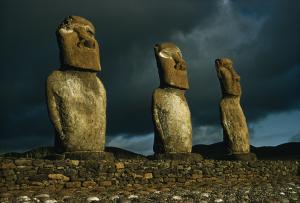- Welcome
- About Life
- National Geographic and Life
- Teacher Resources
- Customizing Life to your course hours
- Interactive Whiteboard Video Tutorial
- Student's Book and Workbook Audio
- CEFR correlations
- Audioscripts (Word)
- Reading Texts (Word)
- Videoscripts (Word)
- Business Writing Worksheets
- Communicative Worksheets
- Extra Practice Activities
- Life Grammar Practice Worksheets
- Multilingual and monolingual word lists
- Ready-made Lessons
- Split editions teacher's book references
- Student's Book Answer Keys
- Web research for Life
- Video
- Test Centre
- Student Zone
The Easter Island statues

A mystery in the South Pacific Ocean
José Tuki is a 30-year-old artist from Easter Island in the South Pacific Ocean. He’s sitting on Anakena beach and he’s looking at enormous statues of people —the moai. The statues are from four feet tall to 33 feet tall. Some of them weigh more than 80 tons. They are hundreds of years old. The moai are made of a type of stone that doesn’t exist on Anakena beach. People made the statues in a different place and then they moved them 11 miles to the beach. ‘How did they do it?’ Tuki asks.
The first Polynesians arrived at Rapa Nui (Easter Island) by canoe hundreds of years ago. This small island is 2,150 miles west of South America. These days, 12 flights arrive every week from Chile, Peru, and Tahiti. In 2011, 50,000 tourists flew to Easter Island. All the tourists go to see the moai.
There are different ideas about how the Rapa Nui people moved the moai. Some historians think the ancestors used ropes and wood and pulled the statues along the ground. The scientist and writer Jared Diamond thinks that many people moved the statues. He also thinks that the people cut down the trees on the island. They needed the wood to move the statues. They also needed a lot of space without trees to grow food. Because they cut down the trees, there was an environmental disaster on the island.
But archaeologists Terry Hunt of the University of Hawaii and Carl Lipo of California State University Long Beach don’t agree with Jared Diamond. They say that it was possible to move the statues with a small number people and a system of ropes. Last year National Geographic Expeditions Council paid for an experiment to test Hunt and Lipo’s idea.
Easter Islander José Tuki says, ‘I want to know the truth, but maybe the island doesn’t tell all its answers.’ He thinks that the moai are very special and powerful and maybe it’s not a good idea to know the truth.
Keywords:
disaster
(n) something very bad that happens and which causes a lot of damage
enormous
(adj) something that is enormous is extremely large in size or amount
ground
(n) the ground is the surface of the earth
grow
(v) if you grow a particular type of plant, you put seeds or young plants in the ground and look after them as they develop
rope
(n) a rope is a thick cord or wire that is used for jobs such as pulling cars or tying things together
stone
(n) a hard solid substance found in the ground and often used for building houses
special
(adj) different from normal, or better or more important than other people or things
system
(n) a set of equipment or parts which are used for doing something
truth
(n) the truth about something is all the facts about it, rather than things that are invented or imagined
wood
(n) wood is the material which forms the parts of a tree
Reading comprehension:
Read the article and choose the correct option.
are modern.
are moving.
are very old.
2 People don't really understand ...
what the statues are made of.
where the statues came from.
how people on the island moved the statues.
3 In general, scientists and historians …
have the same ideas about how the statues were moved.
do not agree about how the statues were moved.
have no idea about how the statues were moved.
Read the article again and choose the correct option.
lives on a beach.
is an artist.
makes statues
5 The moai ...
are statues of animals.
are made of wood.
are very big and heavy.
6 Easter Island ...
is very near to South America.
is in the South Pacific Ocean.
is a large island.
7 Tourists travel to Easter Island …
by boat.
by canoe.
by plane.
8 Some historians think ...
people moved the statues with ropes and wood.
animals pulled the statues along the ground.
people didn’t move the statues.
9 Jared Diamond thinks that ...
there were trees on the island in the past.
people built the statues after a disaster.
people grew a lot of trees on the island.
10 José Tuki ...
knows the truth about the statues.
doesn't know the truth about the statues.
doesn’t think the moai are important.
Extra activities:
Find out more:
Which photo do you think is the best?
How many things from the keywords box can you see?
Is it a real moai statue?